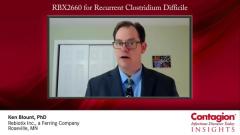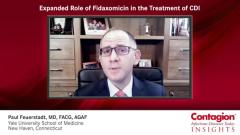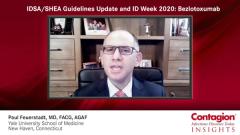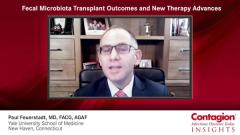
Treatment Recommendations from IDSA/SHEA for CDI
Episodes in this series

Transcript:
Paul Feuerstadt, MD, FACG, AGAF: In February of 2018, the Infectious Diseases Society of America and the Society for Healthcare Epidemiology of America updated their joint guidelines for the first time since 2010, and that update came with a lot of change. Within those guidelines, they recommended treatment for initial infection be based upon severity of infection, specifically, nonsevere infection being defined as a white cell count less than 15,000 and creatinine less than 1.5 mg/dL. If patients met those criteria, then they had nonsevere infection, and it was recommended that they receive either vancomycin, 125 mg 4 times daily for 10 days, or fidaxomicin, 200 mg twice daily for 10 days. Notice that metronidazole was not a recommended therapy. The only time metronidazole was recommended in that initial nonsevere cohort was with patients who did not have access to either vancomycin or fidaxomicin. And for initial severe infection, metronidazole was completely off the table. For initial severe infection, defined by a white cell count greater than 15,000 or creatinine greater than 1.5 mg/dL, patients were only recommended to receive 10-day therapies with either vancomycin or fidaxomicin. For initial fulminant infection, defined by hypotension, shock, ileus and megacolon, we basically throw the book at the patients. We give intravenous metronidazole; we give oral vancomycin. If patients have an ileus, we give per rectum vancomycin, a little bit of prayer, and the patients usually do very well with that therapy.
For first recurrence, the guidelines significantly changed from 2010, where it was recommended that we reuse what was used initially. With these guidelines, for first recurrence, if patients received metronidazole originally, it was recommended that they receive vancomycin, 125 mg 4 times daily for 10 days. If they received vancomycin originally and recurred, it was recommended that they receive fidaxomicin, 200 twice daily for 10 days. And for patients in the middle, or patients who don’t fit those criteria, the clinical practitioner is recommended to use a prolonged vancomycin taper that is usually greater than 6 weeks, with a pulse at the end of that taper.
For 2 or more recurrences, the guidelines went with several different options; one, being a prolonged vancomycin taper greater than 6 weeks, if that hasn’t been given already, or a standard 10-day vancomycin treatment course of 125 mg orally 4 times daily, followed by rifaximin, 3 times daily for 20 days, a so-called rifaximin chaser. And finally, if patients hadn’t received fidaxomicin as yet, they recommended fidaxomicin, 200 mg twice daily for 10 days. But the greatest addition to those guidelines was the comment in 2 or more recurrences, where they recommended fecal microbiota transplantation. They recommended this after 3 completed antimicrobials courses in patients at greatest risk for recurrence. So we can see significant, tangible changes between 2010 and 2018 to these guideline-based treatments.
Transcript Edited for Clarity
Newsletter
Stay ahead of emerging infectious disease threats with expert insights and breaking research. Subscribe now to get updates delivered straight to your inbox.











































































































































































































































































































































